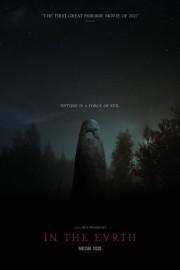In the Earth
**Before I dive into the film itself, the last hour of “In the Earth” contains a considerable amount of strobe lighting and low-frequency sound design that could cause seizures and general discomfort in viewers. If that is something that is triggering to you, it’s probably in your best interest to stay away from this film.
When I originally set out my schedule for Sundance in 2021, Ben Wheatley’s “In the Earth” was going to my final Premiere screening on Friday night. But an opportunity arose that led to me going to another screening that night, meaning I would have to catch up with Wheatley’s film when I had time to do so, which I did the next morning. You can hear my thoughts after that initial viewing below. After seeing it again in preparation for its regular release, however, I wish I had left that schedule as is; Wheatley’s film is not meant to be experienced in the time crunch of a film festival, especially one with a shortened schedule like Sundance was this year. It’s meant to be stewed over and contemplated, and upon rewatch, there’s plenty to do in that respect.
Before anything else, I want to point to the remarkable sound design, and how it works within Clint Mansell’s score. This might be Mansell’s most vital score in the context to the narrative of the film since “Requiem for a Dream,” and I say that as a huge fan of his next score for Darren Aronofsky, “The Fountain.” I’m on record of how much I love the “Wall of Sound” genre of film scoring, that relies on immersive soundscapes rather than isolated musical themes to bring us into the movie, and “In the Earth” represents some of the most extraordinary use of those techniques within the larger framework of the film. Like with “Close Encounters of the Third Kind,” music- or sound, at least- is used to communicate with something science discovers, but is uncertain about. Rather than traditional musical motifs, though, Wheatley’s scientists use Moog synthesizers to create sounds to communicate with nature. Mansell’s score works within the same parameters, and for me, at least, it results in what might be one of the most exciting musical experiences of 2021.
“In the Earth” takes folk horror and blends it with science to tell a story of isolation as frightening as “The Shining.” The movie begins properly with Martin Lowery (Joel Fry) arriving at a nature outpost during a pandemic. (Indeed, Wheatley shot this film in 2020, in the midst of COVID.) He is there not to necessarily seek out a cure for the virus that has the world on lockdown, but to help this outpost do an equipment run and check. His guide is Alma (Ellora Torchia), who tells him about the nature folklore re: spirits of the Earth that he notices in drawings around the outpost. They then walk into the forest, and they see an abandoned camp ground for a family, as well as get assaulted by unknown people who take their shoes. Not long after, they come across Zach (Reece Shearsmith), who appears to have been living out in the woods quite a while, by his setup. Initially, he comes across as someone who can help them on their story, but his real intentions become clearer the longer they stay with him, not always of their choosing.
The film’s structure at the beginning feels like “Annihilation” with the desolate isolation of Tarkovsky’s “Stalker”- both involve quests into nature. While “In the Earth” definitely seems much more like “Annihilation” the more ingratiated Martin and Alma get with Zach and Olivia (Hayley Squires), a former girlfriend of Martin’s whom is doing research not far from Zach’s camp, the spiritual journey Tarkovsky took people on comes back to the forefront when Olivia’s research is unveiled; she is attempting to communicate with nature using sound, to help bring man and nature closer. What transpires, however, is akin to the final act of “The Shining,” where Martin and Alma find themselves captive by the delusions of Zach and Olivia, and the forest becomes a living thing around them that can kill them. I’m not a huge fan of some of Wheatley’s stylistic and editing choices in this last part of the film, and I think some of them are why I didn’t entirely connect with the film back at Sundance, but for most of the movie, his craft decisions as a storyteller are impeccable, and build the dread of his narrative to a level of anxiety and terror that sticks with you.










